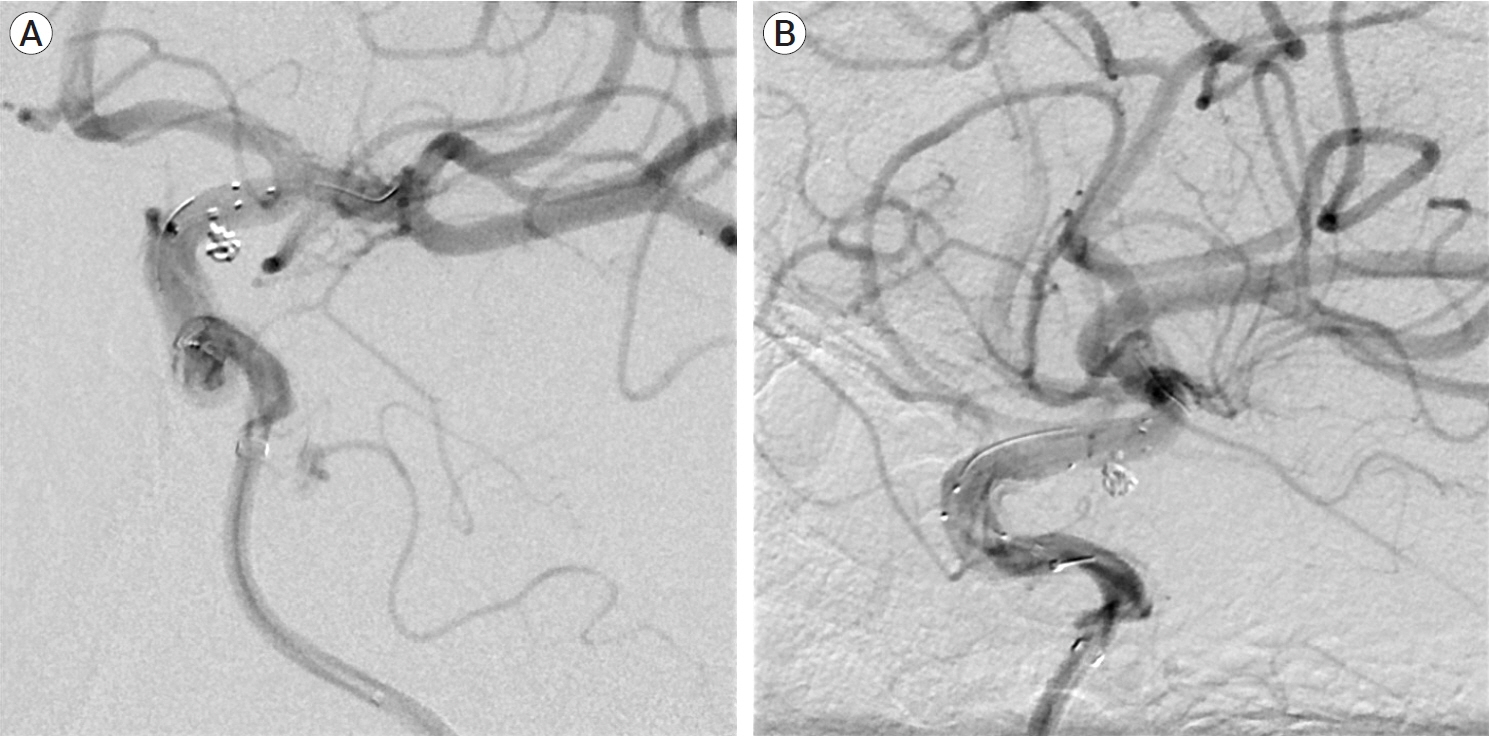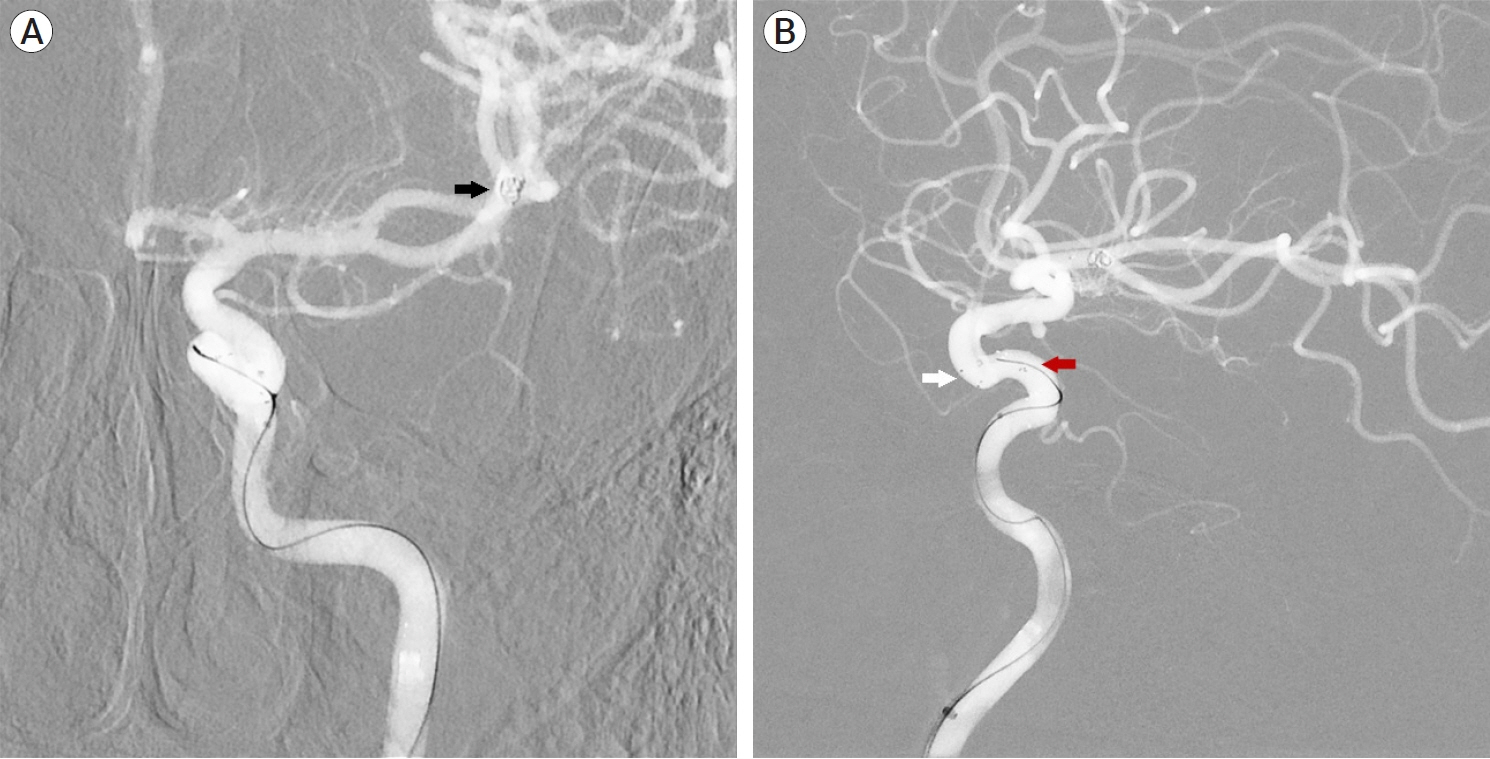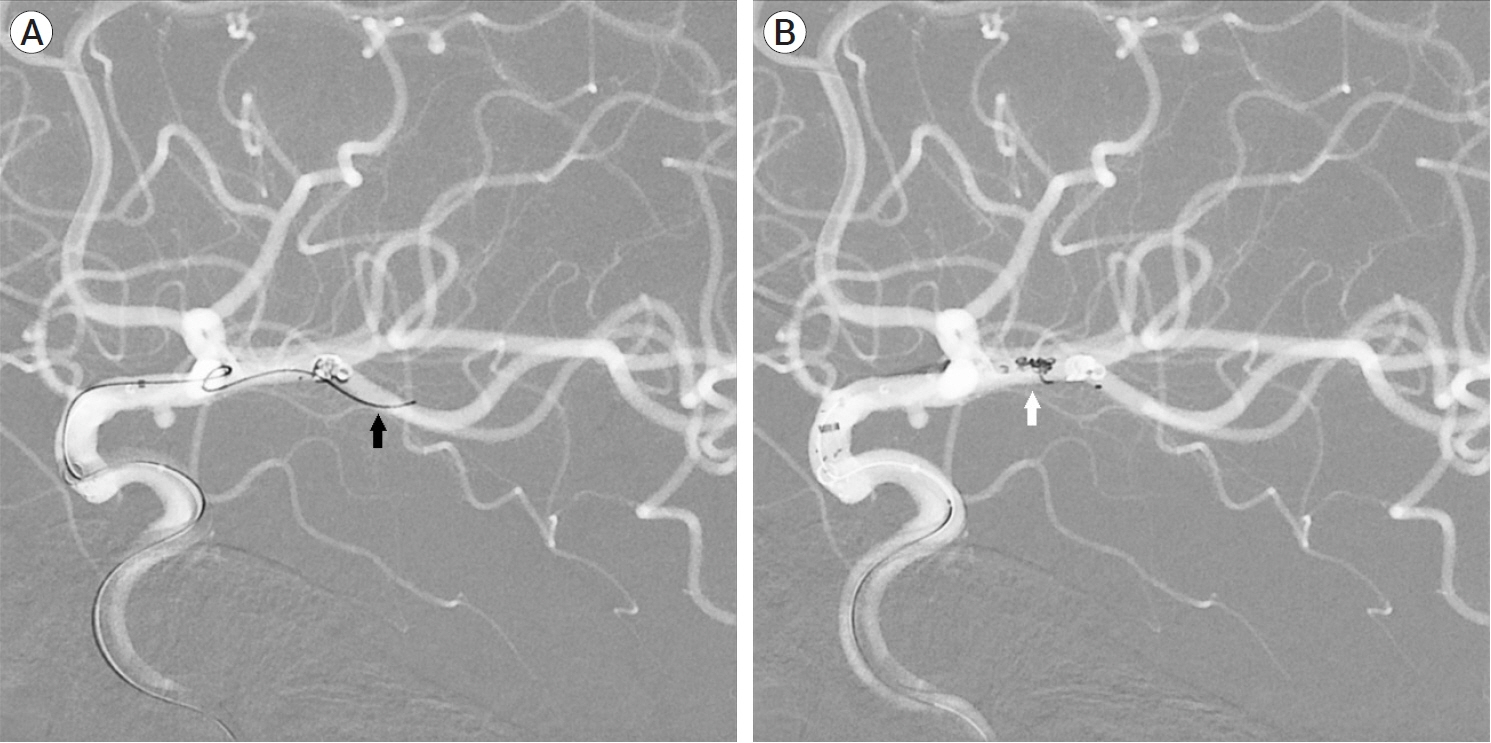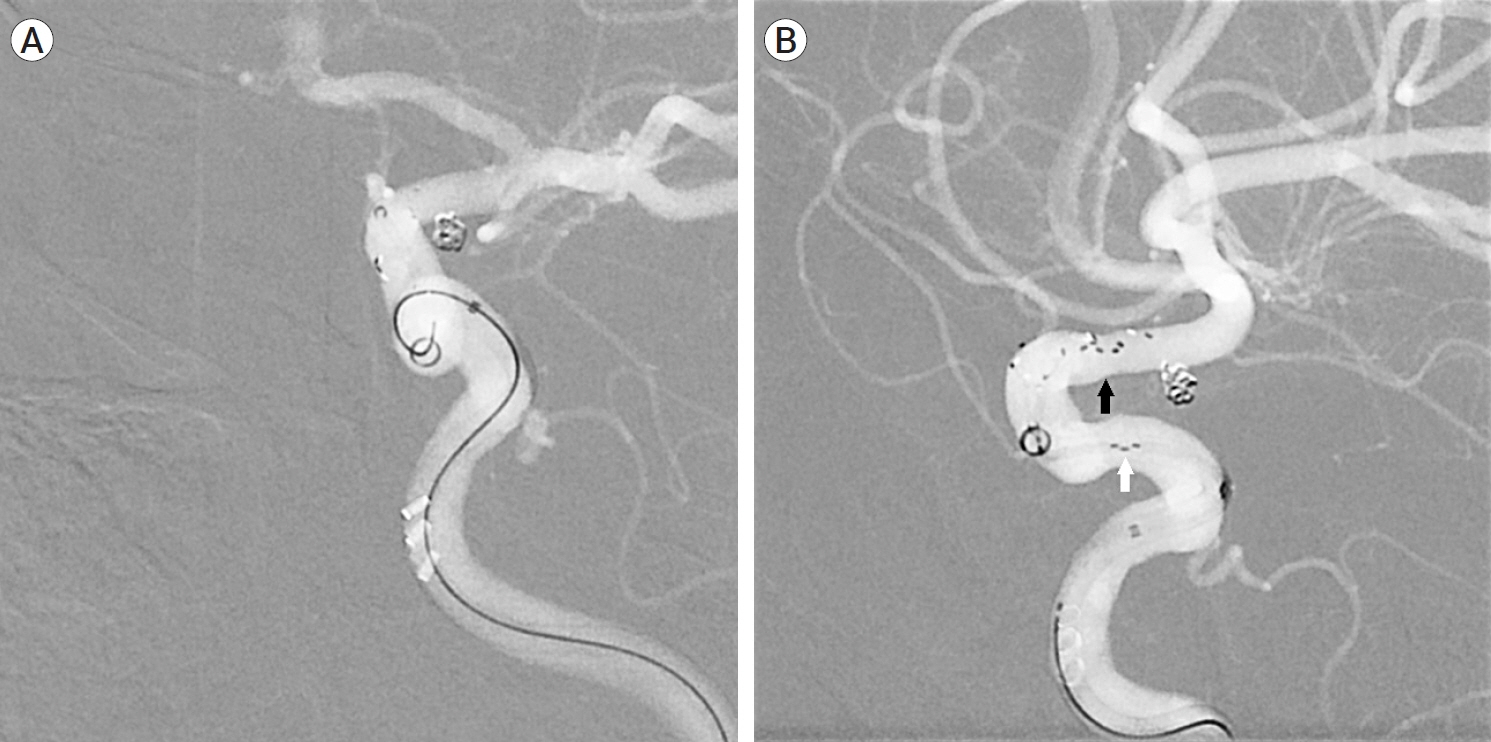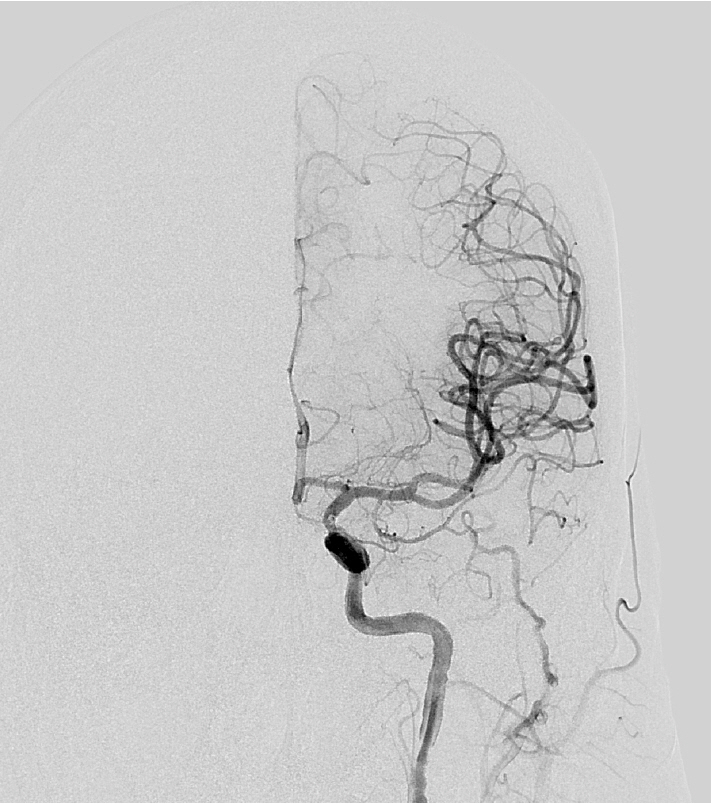J Cerebrovasc Endovasc Neurosurg.
2023 Jun;25(2):196-202. 10.7461/jcen.2022.E2022.04.001.
Migrated coil and damaged stent removal during coil embolization, using an additional, retrievable stent: A case report
- Affiliations
-
- 1Department of Neurosurgery, Ulsan University Hospital, University of Ulsan College of Medicine, Ulsan, Korea
- KMID: 2543516
- DOI: http://doi.org/10.7461/jcen.2022.E2022.04.001
Abstract
- One of the common complications that can occur during coil embolization of cerebral aneurysms, is migration of coil lump alone. The removal of these migrated coils has been reported on a few occasions. On the other hand, rare complications would include the migration of the coil with subsequent stent dislocation. Currently, there is no standardized method to correct the complications of stent dislocation, and very few instances of this complication have been reported previously. In this report, we introduce a case of coil migration combined with stent dislocation. This occurred during coil embolization of an unruptured aneurysm of the distal, left internal carotid artery for a 52-year old woman. We retrieved both the damaged stent and migrated coil using another retrievable stent successfully with no more further complications. In the present report, we describe in detail how we corrected the complication successfully stent, and we discuss why this rescue maneuver is reasonable option for the complication mentioned above.
Figure
Reference
-
1. Abdalkader M, Piotin M, Chen M, Ortega-Gutierrez S, Samaniego E, Weill A, et al. Coil migration during or after endovascular coiling of cerebral aneurysms. J Neurointerv Surg. 2020; May. 12(5):505–11.
Article2. Derakhshani S, Rosa S, Chawda S. Detached coil migration that assisted stent migration, during stent assisted coiling of a recurrent aneurysm: a case report. Neuroradiol J. 2011; Oct. 24(5):791–5.
Article3. Ding D, Liu KC. Management strategies for intraprocedural coil migration during endovascular treatment of intracranial aneurysms. J Neurointerv Surg. 2014; Jul. 6(6):428–31.4. Koseoglu K, Parildar M, Oran I, Memis A. Retrieval of intravascular foreign bodies with goose neck snare. Eur J Radiol. 2004; Mar. 49(3):281–5.
Article5. Kung DK, Abel TJ, Madhavan KH, Dalyai RT, Dlouhy BJ, Liu W, et al. Treatment of endovascular coil and stent migration using the Merci retriever: report of three cases. Case Rep Med. 2012; 2012:242101.
Article6. Leslie-Mazwi TM, Heddier M, Nordmeyer H, Stauder M, Velasco A, Mosimann PJ, et al. Stent retriever use for retrieval of displaced microcoils: a consecutive case series. AJNR Am J Neuroradiol. 2013; Oct. 34(10):1996–9.
Article7. Lessne ML, Shah P, Alexander MJ, Barnhart HX, Powers CJ, Golshani K, et al. Thromboembolic complications after Neuroform stent-assisted treatment of cerebral aneurysms: the Duke Cerebrovascular Center experience in 235 patients with 274 stents. Neurosurgery. 2011; Aug. 69(2):369–75.8. O’Hare AM, Rogopoulos AM, Stracke PC, Chapot RG. Retrieval of displaced coil using a Solitaire® stent. Clin Neuroradiol. 2010; Dec. 20(4):251–4.
Article9. Parthasarathy R, Gupta V, Goel G, Mahajan A. Solitaire stentectomy: ‘deploy and engage’ and ‘loop and snare’ techniques. J Neurointerv Surg. 2018; May. 10(5):e6.10. Simgen A, Kettner M, Webelsiep FJ, Tomori T, Mühl-Benninghaus R, Yilmaz U, et al. Solitaire stentectomy using a stent-retriever technique in a porcine model. Clin Neuroradiol. 2021; Jun. 31(2):475–82.
Article11. Singh DP, Kwon SC, Huang L, Lee WJ. Retrieval of distally migrated coils with detachable intracranial stent during coil embolization of cerebral aneurysm. J Cerebrovasc Endovasc Neurosurg. 2016; Mar. 18(1):48–54.
Article12. Vora N, Thomas A, Germanwala A, Jovin T, Horowitz M. Retrieval of a displaced detachable coil and intracranial stent with an L5 Merci Retriever during endovascular embolization of an intracranial aneurysm. J Neuroimaging. 2008; Jan. 18(1):81–4.
Article
- Full Text Links
- Actions
-
Cited
- CITED
-
- Close
- Share
- Similar articles
-
- Retrieval of Distally Migrated Coils with Detachable Intracranial Stent during Coil Embolization of Cerebral Aneurysm
- Selective Temporary Stent-Assisted Coil Embolization for Intracranial Wide-Necked Small Aneurysms Using Solitaire AB Retrievable Stent
- Rescue Therapy of Inadvertent Coil Migration for Endovascular Treatment of Type II Endoleak
- A Complicated Case of Endovascular Stent Assisted Coil Embolization of an Aneurysm
- Colon perforation due to embolization coil for internal iliac aneurysm

